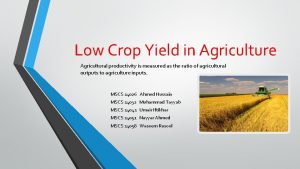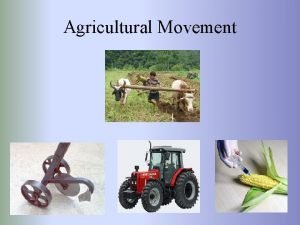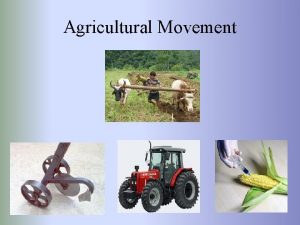AGRICULTURAL PRODUCTIVITY MEANING The word agriculture is derived




















- Slides: 20

AGRICULTURAL PRODUCTIVITY

�MEANING: The word agriculture is derived from the two Latin words agri (implying field) and culture (implying cultivation). Webster dictionary states , “ agriculture is the art or science of production of crops and livestock on a farm. ” in economics, we use the term agriculture as relating to every aspect of cultivation. Main purpose of agriculture is to produce wages goods, such as, food grains, milk, vegetables, pulses, raw material, etc.

Agriculture is the backbone of the Indian economy and the villages are the life line of growth of India. ” “ Agriculture is a very important sector for the sustained growth of the Indian economy. About 70 per cent of the rural households and 8 per cent of urban households are still primarily dependent on agriculture for employment. Since some three-quarters of the population live in rural areas, majority of households thus depend principally on this sector. Though industrialization of the Indian Economy has adversely affected the share of agriculture in the GDP, the fact cannot be ignored that India has undergone a series of successful agricultural revolution starting with the green revolution in wheat and rice in the 1960’s and 1970’s the white revolution in the milk to the yellow revolution in oilseeds in 1980’s. As a result, India has achieved self sufficiency in agriculture. q q. The principle change in 20 th century was green revolution during which all countries experienced massive increase in yield per unit area in time owing largely to greater control of production factor.

� In its broadest sense, water productivity (WP) is the net return for a unit of water used. Improvement of water productivity aims at producing more food, income, better livelihoods and ecosystem services with less water. There is considerable scope for improving water productivity of crop, livestock and fisheries at field through to basin scale. Practices used to achieve this include water harvesting, supplemental irrigation, deficit irrigation, precision irrigation techniques and soil–water conservation practices. Practices not directly related to water management impact water productivity because of interactive effects such as those derived from improvements in soil fertility, pest and disease control, crop selection or access to better markets. � Priority areas where substantive increases in water productivity are possible include: (i) areas where poverty is high and water productivity is low, (ii) areas of physical water scarcity where competition for water is high, (iii) areas with little water resources development where high returns from a little extra water use can make a big difference, and (iv) areas of water-driven ecosystem degradation, such as falling groundwater tables, and river desiccation. However, achieving these gains will be challenging at least, and will require strategies that consider complex biophysical and socioeconomic factors.

q FACTORS DETERMINING AGRICULCURAL PRODUCTIVIY 1. Irrigation facilities Good seeds, manure and fertilizers Agricultural equipments Scientific cultivation Ceilings on landholdings Soil conservation Agricultural marketing Education and research Improvement in the breed of livestock Other factors 2. 3. 4. 5. 6. 7. 8. 9. 10.

q. Importance of agriculture � As you are aware, the recent Indian growth story has been serviceled. Services sector has completely replaced agriculture, which was traditionally the largest contributor to India’s GDP. � However, the fact that agriculture has the smallest share in GDP of only about 14 per cent today from a high of more than 50 per cent , does not belittle its importance for the Indian economy. � This is because first, as we all know, agriculture remains the largest employer having a share of around 60 per cent. Secondly, it holds the key to creation of demand in other sectors and remains by far an important indirect contributor to India’s GDP growth. � The agriculture sector needs to grow at least by 4 per cent for the economy to grow at 9 per cent. Thus, though having a small share, the fluctuations in agricultural production can have large and significant impact on overall GDP growth.

� Thirdly, since food is an important component in basket of commodities used for measuring consumer price indices, it is necessary that food prices are maintained at reasonable levels to ensure food security, especially for the deprived sections of our society. � In fact, food security is emerging as an important policy concern, and the role of agriculture in ensuring equitable access to food has added a new perspective for policy makers.

Progress of per hectare productivity Crop Rice Wheat Cotton Sugarcane Jute maize 1951 668 663 88 3342 1043 704 (kilograms per hectare) 2010 -11 3176 2989 499 70000 2329 2540

� Productivity of Indian agriculture is low as compared to the productivity at the global level. Estimates of yield of rice as of April 2011 in India was 3. 2 tonnes per hectare as against 7. 5 tonnes per hectare in the United States, 6. 7 tonnes per hectare in China and an average of 4. 3 tonnes per hectare for the world (Chart 1). Similar contrast in yields have also been observed in case of wheat and coarse cereals though yield gaps as regard oilseeds were lesser i. e. , 1. 0 tonne per hectare, 2. 7 tonnes per hectare and 2. 1 tonnes per hectare for India, United States and China respectively. Even the most productive States in the country fall short of world standards in terms of yields of major crops.

q What are the Causes of Backwardness of Agriculture in India? 1. Small Size of Holdings 2. Vicious Circle of Poverty 3. Indebtedness 4. Inadequate Irrigation Facilities 5. Lack of Adequate Finance 6. No Scientific Methods of Cultivation 7. Lack of Marketing Facilities 8. Agricultural Research 9. Lack of Productive Investment 10. Social Factors 11. Natural Calamities 12. Poor Livestock 13. Land Policy and Legislation

q. Suggestions Or Remedies To Overcome The Problems 1. Reclamation of Land � The land which has been declared useless due to salinity and water-logging should be reclaimed. Tube-wells should be installed in the affected areas to decrease the salinity. Beds of new canals should be made of concrete to avoid water-logging. These measures should be taken on priority basis to avoid further deterioration of land. 2. Irrigation Facilities � The major problem of agriculture in Pakistan is scarcity of water. Most of the land is lying unused due to this problem. Therefore, it is necessary that the irrigation facilities be extended for increasing agricultural out put. 3. The Use Of Fertilizers � The agricultural yield can also be increased to a great extent by using fertilizers. The use of artificial manure should be introduced through out the country. Due to poverty and illiteracy our farmers hesitate to purchase the fertilizers. 4. Credit Facilities � The use of better seeds, fertilizers and modern implements is not possible without adequate credit facilities for the farmers. The government has extended the existing credit facilities to a large extent. The commercial banks also grant loans to the farmers, but still there is a need for more facilities as our farmers are very poor.

5. Better Seeds � The farmers should be provided better quality seeds at the lowest price and at the right time. Better seeds will ultimately give better yield. 6. Plant Protection � Various plant diseases damage a large part of our crops. But our farmers have no effective control over them. Therefore, preventive and neurative measures should be taken throughout the country. 7. Mechanization � Mechanization of agriculture refers to the use of various equipments the different stages of cultivation. By the use of modern equipments better results can be achieved in the shortest time. 8. Co-operative Farming � Co-operative farming refers to the farming done on the basis of mutual help and co-operation. Under this method the small holdings are conciliated. In this way the owners of small holdings can also use fertilizers and modern equipments jointly. After harvesting, the yield can be distributed among the owners according to their ownership.

9. Education Level � Increase of literacy ratio in rural areas especially in agre-education is the need of the day. The more educated the farmers will be the better will be the results achieved. 10. Marketing Facilities � Marketing procedures should be simplified and various marketing facilities should be provided to the cultivators. 11. Improvement In The Means Of transportation And Communication � The rural areas of the country must be provided with road and railway links with marketing centers and better means of transport and communication should be provided.

q measures for developing the Agricultural sector in India 1. Multiple Cropping: � Multiple cropping aims at maximizing production per unit of land per unit of time by taking three or four crops in a year. By adopting multiple cropping, there are two advantages as of getting increased returns and economy of the farm resources. 2. Expansion of Irrigation Facilities: � Irrigation facilities have increased manifold over time. Several, minor, medium and major irrigation projects have been launched in the country. At the inception of First Five Year Plan, India had only 18% of total irrigated area which at present increased to about 33. 9 percent. 3. Use of HYV Seeds: � HYV seeds have absolutely revolutionized Indian agriculture by increasing yield per acre. Among these, mention may be made of dwarf varieties of wheat PU-18, Kalyan Sona 227, Sona Lika, Hybrid maize, Vijay, Rice I R-8, Jhona 351, Padma and Jaya etc.

4. Plant Protection: � Considerable efforts have been made to protect the crops from the insects and pests. For this purpose, 14 Central Plant Protection Centres have been set up by the Govt. 5. Scientific Methods of Cultivation: � � In the planning period, stress has been laid on the scientific methods of cultivation. It has been emphasized to adopt superior agricultural technology in respect of crop rotation, selection of quality seeds, use of proper manure, treatment of soil, selection of crops etc. In this regard, Haryana Agricultural University Hissar, Punjab Agricultural University Ludhiana, Himachal Agricultural University Palampur, ICAR, Delhi is playing a pioneer role to develop agriculture. 6. Use of Mechanization: � Mechanization is another noteworthy step employed to develop agriculture. Small farmers are assisted with cheap credit facilities through co-operative societies, community development blocks to purchase machinery and other modern equipments.

7. More Use of Chemical Fertilizers: � � Use of chemical fertilizers has also contributed significantly to the growth of agricultural output. Several steps have been taken to encourage the use of cow-dung as manure rather than as fuel. In 1950 -51, 0. 13 million tones of chemical fertilizers was used which in 1980 -81 increased to 5. 52 million tones and further to 12. 54 million tones in 1990 -91. In 1995 -96, the use of chemical fertilizers was recorded to the tune of 15. 7 million tones. 8. Development of Agricultural Land: � Efforts have been made to develop agricultural land during the five year plans. Major success has been achieved in the leveling of land, terracing of fields and contour building. Land surveys are also being conducted. 9. Land Reforms: � In a bid to increase agricultural productivity, land reforms are of immense use. Since the dawn of independence, Govt, of India has undertaken several land reform measures. For instance, Abolition of zamidari system, Fixation of ceilings on Land Holdings, Consolidation of Land Holdings, co-operative farming etc.

q. New national agricultural policy � The first ever National Agriculture Policy was announced on 28 th July, 2000. The National Policy on Agriculture seeks to actualize the vast untapped growth potential of Indian agriculture, strengthen rural infrastructure to support faster agricultural development, promote value addition, accelerate the growth of agro business, create employment in rural areas, secure a fair standard of living for the farmers and agricultural workers and their families, discourage migration to urban areas and face the challenges arising out of economic liberalization and globalization. � A growth rate in excess of 4 per cent per annum in the agriculture sector; Growth that is based on efficient use of resources and conserves our soil, water and biodiversity; Growth with equity, i. e. , growth which is widespread across regions and farmers; Growth that is demand driven and caters to domestic markets and maximizes benefits from exports of agricultural products in the face of the challenges arising from economic liberalization and globalization Growth that is sustainable technologically, environmentally and economically.

� The policy seeks to promote technically sound, economically viable, environmentally non-degrading, and socially acceptable use of country’s natural resources - land, water and genetic endowment to promote sustainable development of agriculture. � The use of bio-technologies will be promoted for evolving plants which consume less water, are drought resistant, pest resistant, contain more nutrition, give higher yields and are environmentally safe. Conservation of bio-resources through their ex situ preservation in Gene Banks, as also in situ conservation in their natural habitats through bio-diversity parks, etc. , will receive a high priority to prevent depletion of bio-diversity. � A major thrust will be given to development of rainfed and irrigated horticulture, floriculture, roots and tubers, plantation crops, aromatic and medicinal plants, bee-keeping and sericulture for augmenting food supply, promoting exports and generating employment in the rural areas. � Development of animal husbandry, poultry, dairying and aqua-culture will receive a high priority in the efforts for diversifying agriculture, increasing animal protein availability in the food basket and for generating exportable surpluses.

� Adequate and timely supply of quality inputs such as seeds, fertilizers, plant protection chemicals, bio-pesticides, agricultural machinery and credit at reasonable rates to farmers will be the Endeavour of the Government. � Rural electrification will be given a high priority as a prime mover for agricultural development. The quality and availability of electricity supply will be improved and the demand of the agriculture sector will be met adequately in a reliable and cost effective manner. � Emphasis will be laid on development of marketing infrastructure and techniques of preservation, storage and transportation with a view to reducing post-harvest losses and ensuring a better return to the grower. � Quality consciousness amongst farmers and agro processors will be created. Grading and standardization of agricultural products will be promoted for export enhancement. Application of science and technology in agriculture will be promoted through a regular system of interface between Science and Technology institutions and the users/potential users to make the sector globally competitive.

THANK YOU
 What is the word audit derived from latin language
What is the word audit derived from latin language The word report is derived from
The word report is derived from The word lens is derived from the latin word
The word lens is derived from the latin word Precis french
Precis french The word bank derived from
The word bank derived from Greek words with meaning
Greek words with meaning Photography is a greek word
Photography is a greek word Definition of forensic scientist
Definition of forensic scientist The word “advent” comes from the latin word which means
The word “advent” comes from the latin word which means Physics derived from greek word
Physics derived from greek word Litera root words
Litera root words Horticulture word
Horticulture word The greatest contributor to our present gymnastics program
The greatest contributor to our present gymnastics program Logia meaning in education
Logia meaning in education Science is latin word
Science is latin word Environment derived from which word
Environment derived from which word Society meaning in education
Society meaning in education Magnet berasal dari kata magnesia
Magnet berasal dari kata magnesia Authority derived from
Authority derived from Greek word of trigonometry
Greek word of trigonometry Conditional evidence
Conditional evidence






































